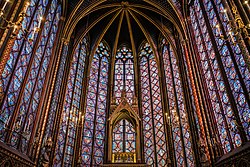
Back Gotiese argitektuur Afrikaans عمارة قوطية Arabic عماره قوطيه ARZ Arquiteutura gótica AST Qotika (memarlıq) Azerbaijani Гатычная архітэктура Byelorussian Гатычная архітэктура BE-X-OLD Готическа архитектура Bulgarian গথিক স্থাপত্য Bengali/Bangla Arkitektouriezh c'hotek Breton
| Gothic architecture | |
|---|---|
Top: West front of Wells Cathedral in England (1225–1240); middle: Sainte-Chapelle in Paris (1238–1248); bottom: tympanum of Rouen Cathedral (15th century) | |
| Years active | Late 12th century–16th century |
| Location | Catholic Europe and West Asia |
| Influences | Romanesque architecture, Byzantine architecture, and possibly Armenian architecture |
| Influenced | Post-Gothic, Gothic Revival architecture, Baroque Gothic |
Gothic architecture is an architectural style that was prevalent in Europe from the late 12th to the 16th century, during the High and Late Middle Ages, surviving into the 17th and 18th centuries in some areas.[1] It evolved from Romanesque architecture and was succeeded by Renaissance architecture. It originated in the Île-de-France and Picardy regions of northern France.[2] The style at the time was sometimes known as opus Francigenum (lit. 'French work');[3] the term Gothic was first applied contemptuously during the later Renaissance, by those ambitious to revive the architecture of classical antiquity.
The defining design element of Gothic architecture is the pointed arch. The use of the pointed arch in turn led to the development of the pointed rib vault and flying buttresses, combined with elaborate tracery and stained glass windows.[4]
At the Abbey of Saint-Denis, near Paris, the choir was reconstructed between 1140 and 1144, drawing together for the first time the developing Gothic architectural features. In doing so, a new architectural style emerged that emphasized verticality and the effect created by the transmission of light through stained glass windows.[5]
Common examples are found in Christian ecclesiastical architecture, and Gothic cathedrals and churches, as well as abbeys, and parish churches. It is also the architecture of many castles, palaces, town halls, guildhalls, universities and, less prominently today, private dwellings. Many of the finest examples of medieval Gothic architecture are listed by UNESCO as World Heritage Sites.
With the development of Renaissance architecture in Italy during the mid-15th century, the Gothic style was supplanted by the new style, but in some regions, notably England and what is now Belgium, Gothic continued to flourish and develop into the 16th century. A series of Gothic revivals began in mid-18th century England, spread through 19th-century Europe and continued, largely for churches and university buildings, into the 20th century.
- ^ Curl, James Stevens; Wilson, Susan, eds. (2015), "Gothic", A Dictionary of Architecture and Landscape Architecture (3rd ed.), Oxford University Press, doi:10.1093/acref/9780199674985.001.0001, ISBN 978-0-19-967498-5, archived from the original on 12 January 2021, retrieved 9 April 2020
- ^ "Gothique ou Opus Francigenum : une architecture sans frontières venue de France (Le) | EHNE". ehne.fr. Retrieved 4 February 2025.
- ^ Binding, Günther (1989). "Opus Francigenum. Ein Beitrag zur Begriffsbestimmung" (PDF). Archiv für Kulturgeschichte (in German) (71): 45–54. doi:10.7788/akg.1989.71.1.45. S2CID 201722797. Archived (PDF) from the original on 25 September 2020. Retrieved 29 November 2020.
- ^ Fraser, Murray, ed. (2018), "Gothic", Sir Banister Fletcher Glossary (21st ed.), Royal Institute of British Architects (RIBA) and the University of London, doi:10.5040/9781350122741.1001019, ISBN 978-1-350-12274-1, archived from the original on 22 May 2020, retrieved 18 May 2020
- ^ Mignon 2015, pp. 8–9.


